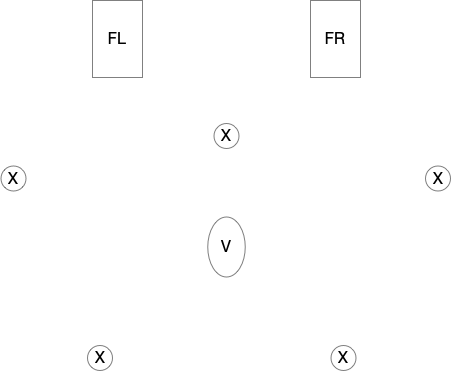GMU:Max and I, Max and Me/Friedrich Wilhelm Albrecht Pittelkow: Difference between revisions
m (→Sketch) |
No edit summary |
||
| Line 1: | Line 1: | ||
== | == Project: Exploring Audio-Visual == | ||
== | |||
[[ | [[File:Max_frpi_1.png|500px]] | ||
=== Idea === | === Idea === | ||
The main goal of the interactive installation is to create an atmosphere consisting of a combination of audio and visuals which can be shaped by the viewer. | The main goal of the interactive installation is to create an atmosphere consisting of a combination of audio and visuals which can be shaped by the viewer. | ||
| Line 38: | Line 13: | ||
=== Sketch === | === Sketch === | ||
FL and FR represent the speakers (Front Left and Front Right). V indicates the viewer facing the speakers and the circles marked with an x represent the light sources. | FL and FR represent the speakers (Front Left and Front Right). V indicates the viewer facing the speakers and the circles marked with an x represent the light sources. | ||
=== Technical solutions === | === Technical solutions === | ||
Sound can be looped samples/ recordings and can be generated by max. | Sound can be looped samples/ recordings and can be generated by max. | ||
For the lights LEDs in a case, which diffuses the light can be used and can be controlled by an Arduino which communicates with max. | For the lights LEDs in a case, which diffuses the light can be used and can be controlled by an Arduino which communicates with max. | ||
=== | === Inpiration and References === | ||
[https://www.essl.at/works/apres-lavant.html après l'avant] a binaural electronic sound performance based on the piece "tenet opera rotas" by Karlheinz Essl. | |||
[[/ Process]] | |||
Revision as of 12:45, 10 June 2021
Project: Exploring Audio-Visual
Idea
The main goal of the interactive installation is to create an atmosphere consisting of a combination of audio and visuals which can be shaped by the viewer. The viewer stands in front of a pair of speakers and is either surrounded by lights (or views a projection on a screen).
The viewer has the opportunity to shape the atmosphere using a smartphone or tablet. It should be possible to crossfade between different states of the installation.
These atmospheres shall represent different environments. E.g. a city or a forrest. The viewer could now mix the city with the forrest and experience this combinations.
Sketch
FL and FR represent the speakers (Front Left and Front Right). V indicates the viewer facing the speakers and the circles marked with an x represent the light sources.
Technical solutions
Sound can be looped samples/ recordings and can be generated by max. For the lights LEDs in a case, which diffuses the light can be used and can be controlled by an Arduino which communicates with max.
Inpiration and References
après l'avant a binaural electronic sound performance based on the piece "tenet opera rotas" by Karlheinz Essl.
